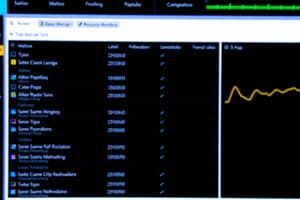Podcast
Questions and Answers
Which of the following resources are available for monitoring in a system? (Select all that apply)
Which of the following resources are available for monitoring in a system? (Select all that apply)
- CPU power (correct)
- Memory (correct)
- Storage (correct)
- Network speed
- Bandwidth (correct)
Monitoring system performance is only done when the system is running smoothly.
Monitoring system performance is only done when the system is running smoothly.
False (B)
What are the three steps involved in performance monitoring?
What are the three steps involved in performance monitoring?
- Monitor resource shortages, 2. Analyze data and resolve problem, 3. Monitor to ensure resolution.
What is the maximum data transfer rate that bandwidth describes?
What is the maximum data transfer rate that bandwidth describes?
What does CPU utilization reaching 100% signify?
What does CPU utilization reaching 100% signify?
A gigabit Ethernet connection has a bandwidth of ______ Mbps.
A gigabit Ethernet connection has a bandwidth of ______ Mbps.
Name one factor that complicates monitoring disk drive performance.
Name one factor that complicates monitoring disk drive performance.
Flashcards are hidden until you start studying
Study Notes
Resource Monitoring
- Resource monitoring is a system application for real-time observation of hardware (CPU, memory, disk, network) and software usage.
- Essential resources available for monitoring include CPU power, bandwidth, memory, and storage.
System Performance Monitoring
- System performance monitoring usually occurs when performance issues arise, such as slow system response or program failures.
- A three-step approach guides performance monitoring:
- Identify resource shortages causing performance problems.
- Analyze monitoring data to determine a resolution strategy.
- Re-monitor to confirm that performance issues have been resolved.
- Monitoring is typically brief but detailed in scope.
Monitoring Considerations
- Monitoring involves more than just observing the four resources; it requires analyzing various performance metrics.
- For instance, evaluating disk drive performance may include:
- Available free space
- Average I/O operations per second
- Average completion time for I/O operations
- Distribution of read vs. write operations
- Average data volume for read/write operations
Monitoring CPU Power
- A CPU consists of numerous interconnected processing units responsible for executing software instructions, performing calculations, making logical decisions, and facilitating communication with other system components.
- Basic CPU monitoring checks whether CPU utilization ever reaches 100%, indicating resource limits.
- Investigating detailed CPU utilization data helps identify primary consumers of processing power during peak usage periods.
Monitoring Bandwidth
- Bandwidth measures the maximum data transfer rate of a network or Internet connection, expressed in units like Mbps (megabits per second).
- Example bandwidths include:
- Gigabit Ethernet connection: 1,000 Mbps (125 MB/s)
- Cable modem connection: 25 Mbps
- Bandwidth indicates the capacity of a connection, not the speed at which data travels, making it a crucial factor in assessing network performance.
Studying That Suits You
Use AI to generate personalized quizzes and flashcards to suit your learning preferences.




